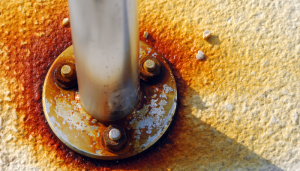
Corrosion protection in building materials has a relevant weight when building in susceptible environments. Considering the right coating for the products used, the distance from the environment and how exposed the materials will be can help you to define what type of corrosion protection is adequated for your project. The question is what corrosion protection is and how it is applied in building materials?
A commonly asked question, what is corrosion protection and is it necessary? The answer is yes. Corrosion on metal is simply defined as the tendency of a metal to convert to its natural stable form as oxides, especially when exposed to atmospheric elements such as oxygen, hydrogen and sometimes by exposure to electric current. A common form of corrosion is in the form of iron oxide when it is exposed to oxygen in the presence of water. Rust can also form in an oxygen-deprived environment where iron is exposed to chloride, and it is commonly seen in products used in/ close to coastal areas or the presence of a saltwater pool.

Corrosion protection on steel can be done in numerous ways such as painting, coating with oil, applying drying agent etc. Corrosion protection on building brackets in Australia are often done with using pre-galvanised steel that are corrosion protected with a layer of a sacrificial anode, which is used to provide efficient cathodic protection on steel. An article published in the VUETRADE blog page explains briefly the science on how sacrificial anodes protect the steel base from corroding. Thicker steel profiles for heavy-duty timber connectors is however usually coated with Hot Dipped Galvanise as the means of corrosion protection.
In certain environment where sacrificial anode (pre-galvanised steel) and Hot Dipped Galvanised as corrosion protection is still not sufficient, especially in areas with high salinity and humidity where corrosion attack on steel are often caused by exposure to chloride (seawater, saltwater pool, heavy industries etc), usage of non-corrosive metals such as Stainless Steel shall be used as an alternative. Two grades of commonly used Stainless Steel in the building industries are Stainless Steel 304 and Stainless Steel 316. SS316 being the superior stainless steel contains an additive namely Molybdenum that increases the corrosion resistance of the stainless steel. Another useful piece of an article detailing the full difference of SS304 and SS316 would provide valuable information on the difference between the two Stainless Steel grade.
For applications exposed to an environment with a high risk of corrosion e.g. saltwater pools, coastal areas and industrial areas, the usage of the correct grade of stainless steel is prefered over standard corrosion protection.